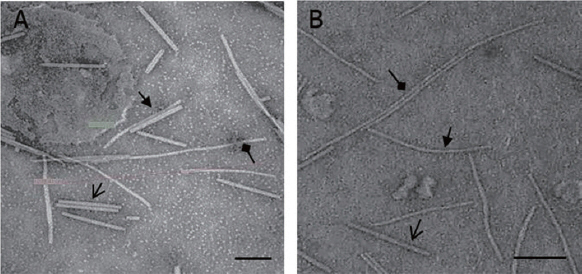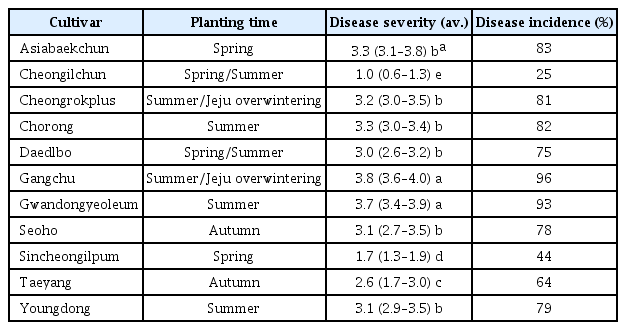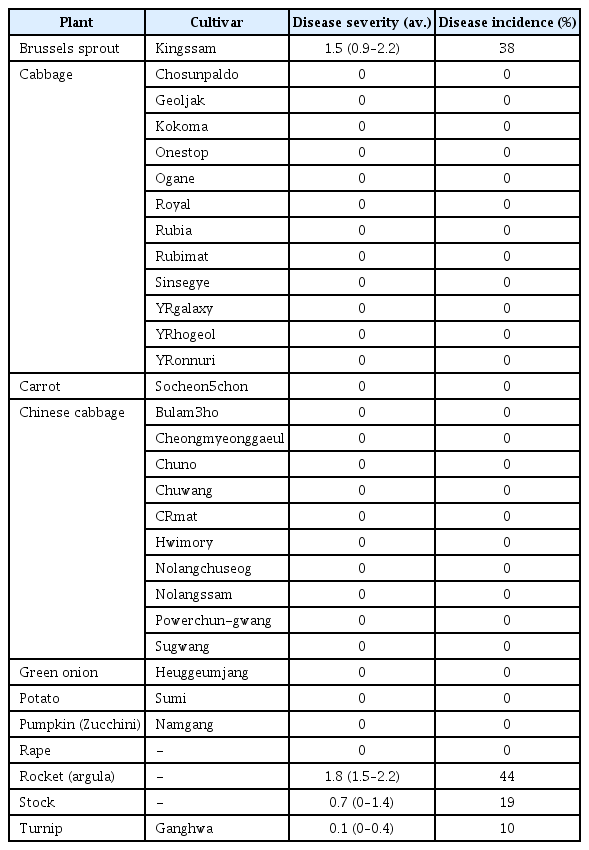국내 지황에 발생하는 바이러스병 발생 현황
The Incidence of Virus Diseases in Rehmannia glutinosa in Korea
Article information
Abstract
While rehmannia (Rehmannia glutinosa Libosch) was identified as a host of at least five viruses, including Rehmannia mosaic virus (ReMV), Youcai mosaic virus (YoMV), Broad bean wilt virus 2 (BBWV2), Plantago asiatica mosaic virus (PlAMV), and Rehmannia virus 1 (ReV1), viral incidence surveys have not been performed yet in rehmannia fields in Korea. In this study, we performed field surveys during 2017–2018 to investigate the incidence of 5 major viruses in rehmannia. A total of 145 symptomatic samples were collected from the rehmannia fields in major cultivation areas of Korea. Molecular diagnosis assays showed that all the collected leaf samples were infected with more than two viruses. Particularly, two species of Tobamovirus, ReMV and YoMV, were detected in all the samples. In addition, our analysis showed that the root stocks of 4 rehmannia cultivars were infected with at least two viruses. Since rehmannia is propagated by vegetative propagation, it is highly important to produce virus-free root stocks of rehmannia to control virus diseases in rehmannia.
지황은 현삼과의 다년생 초본으로 한국을 비롯한 중국, 일본 등에 분포하며 주로 영양번식에 의해 재배되는 약용작물이다. 주요 이용 부위는 뿌리로 가공방법에 따라 생지황, 건지황, 숙지황으로 구분되는데 각 종류에 따라 약재 성질이 다르다고 알려져 있다. 생지황과 건지황은 주로 해열, 지혈 및 이뇨작용에 효능이 좋으며 숙지황은 자양강장 및 당뇨병 치료와 혈압강하, 면역강화에 효능이 있다고 알려져 있다(Cho, 2012; Jang 등, 2011; Lee와 Seo, 2004; Li 등, 2012; Oh 등, 2011). 최근 고소득 작물로 인식되어 약용작물 중 국내 재배면적이 꾸준히 증가하고 있는 추세이다.
2016년에 음성의 지황 재배포장에서 잎에 황화, 노란 반점, 모틀 증상 및 변색, 괴저 등과 같은 바이러스 증상과 함께 포장 전반에 생육이 저조해지는 증상을 확인하고 바이러스 감염 의심 시료들을 채집하여 감염 바이러스를 동정한 바 있다. 그 결과, Rehmannia mosaic virus (ReMV), Youcai mosaic virus (YoMV), Broad bean wilt virus 2 (BBWV2), Plantago asiatica mosic virus (PlAMV), Rehmannia virus 1 (ReV1)의 총 5종의 바이러스 감염이 확인되었다(Kwak 등, 2018; Kwon 등, 2018a, 2018c; Lim 등, 2016). ReMV와 YoMV는 길이가 약 350 nm인 Tobamovirus 속에 속하는 막대형 입자형태의 바이러스로 즙액이나 접촉에 의해 전염되는 바이러스이다(Kubota 등, 2012; Kwon 등, 2018a; Lim 등, 2016; Zhang 등, 2008). BBWV2는 직경이 약 25 nm인 구형 바이러스로 Fabavirus 속에 속하며 기주범위가 매우 넓은 바이러스이며 즙액 및 진딧물에 의해 매개된다(Ying 등, 2010). PlAMV는 길이가 약 450 nm인 Potexvirus 속에 속하는 사상형 바이러스로 주로 즙액 전염한다고 알려져 있다(Kwak 등, 2018). ReV1는 길이가 약 1,500 nm인 사상형 바이러스로 Closterovirus 속에 속하며 즙액에 의해서는 전염되지 않고 진딧물에 의해 전염되는 바이러스로 구명되었다(Kwon 등, 2018c).
본 연구에서는 지황에서 보고된 5종의 바이러스를 대상으로 국내 지황 재배포장의 바이러스 발생현황을 조사하였다. 2017–2018년에 지황의 국내 주요 재배지역인 충북 음성과 제천, 충남 금산, 전북 정읍, 전남 나주 및 경북 영주 등에서 바이러스 감염 잎 시료를 채집하여 조사하고 국내 품종 별 종근에서도 바이러스 감염 현황을 조사하였다. 바이러스 감염확인은 주로 전자현미경과 유전자 진단법을 이용하여 수행하였다.
지황의 국내 주요 생산지역 6곳의 농가 및 시험포장에서 총 145개의 잎 시료를 채집하였다. 채집시기는 정식 후 생육 초기인 5월 하순부터 7월 초순과 수확 전 생육 후기인 9월 하순부터 10월 중순까지 나누어 실시하였다. 지황 포장에서 발견되는 주요 바이러스 증상은 잎의 모자이크 및 모틀 증상과 노란반점, 엽맥괴사 등이었으며, 특히 신초에 심한 모자이크와 함께 잎이 말리며 요철되는 증상을 관찰할 수 있었다(Fig. 1). 포장의 육안조사 결과 대부분의 지황에서 바이러스 증상이 관찰되었다. 유전자 진단에 앞서 채집한 잎 시료는 dip method에 의한 direct negative staining법으로, 투과전자현미경(transmission electron microscope, TEM)으로 검경하였을 때 높은 농도로 바이러스 감염여부를 확인할 수 있었고 막대형과 2종의 사상형 바이러스가 함께 관찰되었다(Fig. 2A). 전자현미경의 해상도가 낮아 구형 바이러스는 관찰되지 않았다. 감염 바이러스의 정확한 진단을 위해 total RNA를 추출하고 5종 바이러스의 특이 프라이머(Table 1)를 이용하여 기존 방법에 의해 유전자 진단하였다(Kwon 등, 2018b). 진단 결과, 모든 시료에서 바이러스가 검출되었고, 특히 ReMV와 YoMV는 전 채집시료에서 진단되었다. 지역에 따라 금산과 정읍 시료는 ReMV, YoMV와 함께 BBWV2 3종이 전 시료에서 모두 검출되었고 음성 시료는 ReMV, YoMV, PlAMV 3종이 모든 시료에서 복합감염 된 것으로 조사되었다. 바이러스 종류별 발병률은 ReMV와 YoMV (100%), BBWV2 (81%), ReV1 (49%), PlAMV (34%) 순으로 많이 발병됨을 확인하였다(Table 2).

Various virus symptoms on Rehmannia glutinosa (A) Yellow mosaic symptoms induced in plants co-infected with Rehmannia mosaic virus (ReMV), Youcai mosaic virus (YoMV), Broad bean wilt virus 2 (BBWV2), and Rehmannia virus 1 (ReV1). (B) Mosaic and leaf curl symptoms induced in plants co-infected with ReMV, YoMV, and BBWV2. (C) Vein necrosis and yellowing symptoms induced in plants co-infected with ReMV, YoMV, BBWV2, PlAMV, and ReV1.

Detection of virus particles from leaves (A) and roots (B) of Rehmannia glutinosa samples by transmission electron microscopy. Three types of virus particles (tobamovirus-like, potexvirus-like, and closterovirus-like particles as indicated with open arrows, triangle arrows and diamond arrows, respectively) were observed. Scale bars=200 nm.
지황 감염 시료 진단 결과, 2종 이상의 바이러스가 함께 검출되는 것으로 나타나 복합감염 양상을 분석하였다. ReMV와 YoMV 2종 복합감염은 5.5%인 반면, 3종 복합감염과 4종 복합감염은 43.4%와 33.2%로 매우 높게 나타났다. 이들 중 가장 높게 나타나는 조합은 ReMV+YoMV+BBWV2 (31.7%)와 ReMV+YoMV+BBWV2+ReV1 (22.8%)였다. 5종 바이러스가 모두 감염되어 있는 조합도 17.9%로 매우 높게 나타났다(Table 3).
지황의 높은 바이러스 발병률의 원인을 조사하기 위해 국내 지황 품종의 종근에서 바이러스 진단을 수행하였다. 지황은 농가에서 수확한 지황 뿌리를 보관한 후 이듬해 종근으로 사용하고 있어 종근의 바이러스 감염여부는 이후 재배 시 바이러스 발생의 주요 요인이 될 수 있다. 국내 재배 지황 4품종(고강, 토강, 다강, 원강)에 대하여 품종 별로 5개씩 종근을 채집하고 각 종근에서 바이러스 감염 양상을 조사하였다. 유전자 진단 결과 품종에 관계없이 서로 유사한 감염양상을 보였으며, 5종 바이러스가 모두 감염된 종근은 20개 중 7개였고 4종 바이러스 감염은 6개, 3종 바이러스 감염은 4개, 2종 바이러스 감염은 3개로 나타났다(Table 2). 잎 시료 분석 결과와 동일하게 종근에서도 ReMV와 YoMV는 100% 검출되었다. 한편, 종근에서 바로 dip method를 통한 전자현미경 검경이 가능한지 알아보기 위해 5종 바이러스가 모두 검출된 종근을 대상으로 TEM을 관찰하였다. 잎 시료에서와 마찬가지로 구형 바이러스를 제외하고는 상당히 높은 밀도의 막대형과 2종의 사상형 바이러스 입자를 관찰할 수 있었다(Fig. 2B). 지황종근의 바이러스 감염 결과는 포장에서 조사된 높은 바이러스 발생률의 원인이 바이러스 감염 종근일 가능성이 높음을 시사한다. 바이러스에 감염된 지황 식물체는 뿌리에 바이러스가 축적되어 있다가 종근으로 정식된 이듬해 포장에서 바이러스가 감염된 채 생육되었고, 재배 중 작업 시 접촉이나 또는 진딧물 등 바이러스 종류별 전염 방식에 의해 다시 주변 식물체로 전반되어 지황 포장에 바이러스병이 만연하게 된 것으로 예측된다.
지황에 감염하는 5종의 바이러스들이 지황 생육 및 생산량, 생산 품질에 어떻게 영향을 주는지는 아직 구명되지 않았다. 바이러스에 감염되지 않은 건전묘의 확보가 필요한 시점이다. 지황의 번식이 주로 영양체에 의해 이루어지고 있지만 종자 확보 후 실생묘를 활용할 경우 바이러스 축적이 제한되어 예방에 도움이 될 것으로 예상된다. 바이러스에 감염되지 않은 지황 건전묘 확보를 통해 바이러스병의 전염 특성 및 피해 양상을 분석할 예정이며 예방기술과 관리방안을 확립하여 고품질의 지황 생산에 도움이 되기를 기대한다.
요 약
최근 국내 지황에서는 ReMV, YoMV, BBWV2, PlAMV, ReV1 등 5종의 바이러스 감염이 확인되었다. 국내 주요 지황 재배지역의 포장에서 지황 바이러스의 발병률을 조사하기 위해 2017년부터 2018년까지 여섯 지역의 포장에서 바이러스병 조사를 실시하였다. 지황에 나타나는 주요 바이러스 증상은 잎에 모자이크와 노란 반점 및 변색이었으며 생육이 저조해지는 증상이 관찰되었다. 총 145개의 시료를 채집하여 5종 바이러스에 대한 유전자 진단을 실시한 결과, 전 시료에서 2종 이상의 바이러스가 복합 감염되어 있음을 확인하였다. 지황은 뿌리로 영양번식하는 재배 특성 상 품종별 종근에서도 바이러스 감염 여부를 조사하였으며, 종근에서도 5종의 바이러스가 검정됨에 따라 지황에서의 바이러스병 관리를 위해서는 무병 종근의 생산 및 보급이 매우 중요할 것으로 판단된다.
Acknowledgements
This work was supported by a grant from the Basic Research Program (PJ01260902) of National Institute of Horticultural and Herbal Science, Rural Development Administration, Republic of Korea.



